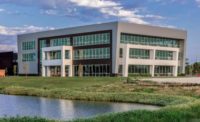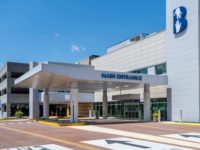Design of Innovation Campus Centers on Sustainability

The first academic building for Virginia Tech’s Innovation Campus in Alexandria features a design centered on the principles of sustainability, health and wellness, green and social spaces, accessibility, connectivity, flexibility and integrated technology.
Architectural renderings of the building — designed by SmithGroup, one of the world’s preeminent integrated design firms — were filed with the city this month as part of a Development Special Use Permit concept submittal.
“This project is a bellwether for what we are trying to achieve through our new campus, creating a place that provides the space and environment to foster collaboration and the creation of bold new ideas,” said Lance Collins, the incoming vice president and executive director of the Innovation Campus. “University Architect Liza Morris worked with SmithGroup, and our campus master planner, Sasaki, to create a unique project that has connectivity at its core.”
Virginia Tech announced plans for the new campus as part of the state’s successful bid to attract Amazon to the region. The Innovation Campus will make its home in the first phase of a new mixed-use development and innovation district in North Potomac Yard which JBG SMITH is developing, just steps away from the future Potomac Yard Metrorail Station.
The Innovation Campus will be comprised of three buildings on about four acres at the northern end of phase 1, near Alexandria’s border with Arlington County. The other six buildings in this phase will house office, residential and ground-level retail space, according to a preliminary plan filed last year with the city.
SmithGroup was chosen through a public process to provide integrated architecture and engineering design services for Academic 1. The university expects to break ground in 2021 and welcome students, faculty and staff into the completed building in fall 2024.
“We are proud to be working with Virginia Tech on this transformational new campus, which will change the face of computer science and redefine the role of the land-grant university for the 21st century,” said David Johnson of SmithGroup. “The university’s goal is to re-center computer engineering in a humanist context, and we brought to life an inclusive setting that will help accelerate knowledge creation and solutions at the intersection of humanity and technology.”
When completed, the 300,000-square-foot building will provide instruction, research, office, and support spaces for graduate-level programs in Computer Science and Computer Engineering, as well as select other programs. Experiential learning environments within this building will be designed to enhance the Virginia Tech experience including flexible multi-purpose areas, research and testing labs, and maker spaces.
SmithGroup is utilizing state-of-the-art computational and generative design techniques to inform the building’s unique geometry. The form was sculpted to capture the sun’s light and energy to maximize photovoltaic power generation. The building will be capped by a solar array and photovoltaics will be incorporated into the glass of the facade. It will also be staged to deploy sewage water energy exchange and geothermal energy to offset energy usage in future phasing.
The academic building incorporates opportunities for daylight, while addressing solar heat gain, glare and occupant comfort. Occupants will have access to nature through connection to open space and parks in the district, and within the building via multiple terraces. The ground floor will be welcoming and active, with exhibits in the lobby and transparency toward the campus green. The university can put science on display to better connect with the local community and attract future students.
SmithGroup is also taking inspiration from Virginia Tech’s Blacksburg campus by including dolomite limestone (“Hokie Stone”) in the landscape, and together with the university’s staff, is exploring special use of the stone at the base of the building, to balance the glass and metal facades with the warmth and solidity of natural stone.
“It’s exciting to finally be able to share our full vision for the campus,” said Morris, Virginia Tech’s assistant vice president for planning and university architect. “We also look forward to our continued collaboration with the City of Alexandria and JBG SMITH as we anchor this dynamic new innovation district.”
Looking for a reprint of this article?
From high-res PDFs to custom plaques, order your copy today!





